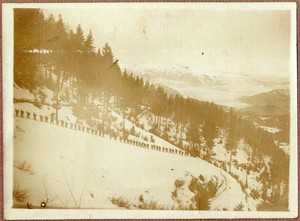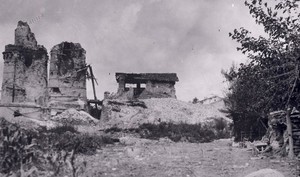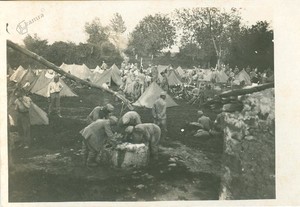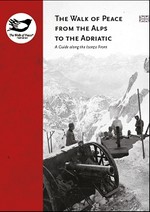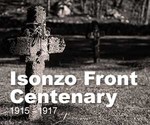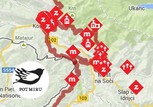The Isonzo Front
Between the end of May 1915 and the end of October 1917, the 93-kilometre stretch of land along the Soča (Isonzo) River saw twelve battles between Austro-Hungarian and Italian forces. The Austro-Hungarian 5th army defending the territory along the line Rombon-Bovec (Plezzo)-Tolmin (Tolmino)-Sabotin-Gorica (Gorizia)-Kras (Karst)-Devin was under the command of Svetozar Borojević von Bojna, while the Italian army was lead by Count Luigi Cadorna. In the course of two and a half years, there were eleven Italian offensives and one Austro-Hungarian/German offensive (Caporetto Breakthough).
The battles caused a huge number of casualties and material damage, as well as the destruction of towns and landscape. The aggressor – the Italian army – paid dearly for their limited successes. At the end, in the few days of the twelfth battle, the Italians lost all the territory acquired in blood, and withdrew to the Piave River.
The First Battle of Isonzo (23 June–7 July 1915). The Italians planned to seize the Tolmin area and break through along the line between Plave and the Adriatic. With the exception of the partial occupation of the western edge of the Karst Plateau by Sredipolje (Redipuglia), Romjan (Vermegliano) and Selce (Selz), they failed.
The Second Battle of Isonzo (18 July–3 August 1915). The attackers focused on the Gorizia bridgehead and the Karst Plateau, but in spite of suffering numerous casualties, little was gained. In the Karst region, they captured a 200-600 m wide strip of land between Martinščica and Griža. They were repelled at the Gorizia bridgehead, while at Krn they succeeded in capturing Mount Batognica, and the Austrians retreated to a defensive line.
The Third Battle of Isonzo (18 October–4 November 1915). This time Italians tried their luck with a frontal attack between the Adriatic and Rombon. In the upper Soča (Isonzo) estuary they got as far as seizing the first Austro-Hungarian defensive trench in the region of Mrzli vrh. Their attempted attack on Banjščice (Bainsizza) Plain from the bridgehead at Plave was unsuccessful; the Gorizia bridgehead and Gorizia remained in the hands of the defenders, and the situation on the Doberdob (Doberdo) plain was the same.
The Fourth Battle of Isonzo (10 November–2 December 1015). The scope of the attack was narrowed, focusing on thirty-three km from Plave to Sv. Mihael, although preparatory artillery barrages covered the entire front. Gorizia and Tolmin were likewise victims of Italian artillery, while Gorizia was the target of Italian bombers and their lethal loads. In the Tomin area, Italian units continuously assaulted the Mrzli vrh-Vodil vrh section and took control of a few trenches near Dolje.
They were partially successful at Zagora above Plave, taking the rear at the church at Oslavje. They advanced as far as the Austro-Hungarian front line trenches by Podgora on the north-western slopes of Sv. Mihael hill and on the western edge of Martinščica.
The Fifth Battle of Isonzo (11 March–16 March 1916). It was poorly prepared and comprised of local assaults. The Italians took a few trenches in the Karst, while the Austrian recaptured some positions in the Krn Mountains (Vrata–Kota 1870).
The Sixth Battle of Isonzo (4 August–16 August 1916). The Italians planned to occupy Goricia and the Doberdob plain. On 9 August, their units entered Gorizia and forced the units defending the Karst, especially the Doberdob plain, to retreat. The Austrians held the defensive positions on the left bank of Soča (Isonzo) River while the trenches there had barely been dug. They held most of their positions in the central and upper Isonzo Valley. In the second phase of the offensive, the defenders managed to stop the Italians from breaking through to the Banjščica Plain and thus from entering the Vipava Valley and surrounding their units in the Karst. The planning of future Italian offensives was based on the fact that they occupied Gorizia, the demand of Italian politicians to acquire Trieste at any cost and the realisation of the Italian high command that the sixth offensive had been prematurely halted, since the Austro-Hungarian side had not managed to fortify a third and fourth lines of defence. Future Italian offensives were aimed at Fajti Hill (Monte Faiti), Trstelj and Grmada.
The Seventh Battle of Isonzo (13 September–17 September 1916). This four-day offensive took place between the Vipava River and the Adriatic. The attackers succeeded in taking Miren Castle and penetrating the lines of defence between Lokvica and Opatje selo up to 500–1000 metres. The defenders fought off the attacks and prevented Italian units from penetrating through the Rožna Valley and Mark into the Vipava Valley and across Fajti Hill (Monte Faiti) towards Trstelj.
The Eighth Battle of Isonzo (9 October–12 October 1916). This Italian offensive was aimed at Fajti Hill (Monte Faiti) and Trstelj. Some 460,000 men were sent into this 4,000-metre section. The defenders pulled back to the next line of defence between Lokvica, Hudi Log and Lukatič. Further north, between the Vipava River and Gorizia, the defenders held almost all their positions except for Šober Peak.
The Ninth Battle of Isonzo (31 October–4 November 1916). The offensive encompassed the territory between The Adriatic Sea and Plave, with Trieste as the objective. The fiercest battles were fought between Hudi Log and Volkovnjak in the northern part of the Karst Plateau. The defenders withdrew to the third line of defence between the great Fajti Hill (Monte Faiti) and Kostanjevica na Krasu (Castagnavizza). The defenders’ main defensive position was in the southern part of the Karst plateau.
The Tenth Battle of Isonzo (12 May–5 June 1917). The Italians planned battles between the Adriatic and Avče along a 50- kilometre front. They planned to occupy Austrian positions east of Gorizzia (Sv. Danijel, Škabriel (Monte San Gabriele), Sv. Gora, Vodice, Kuk (Cucco)) and later move on to positions between Grmada and Trstelj, thus opening a route to Trieste. They succeeded in widening the bridgehead on the left bank of the Soča (Isonzo) River by Plave and breaking through towards Solkan (Salcano), Zagora, Kuk (Cucco) and Vodice. In spite of numerous Italian attempts to seize it, the defenders held Škabrijel. The Austro-Hungarians launched a counter-attack on 4 and 5 June, retaking their positions at Grmada and Jamlje and reversing some of the Italian successes in Karst. The Italians repelled their advance at Fajti Hill.
The Eleventh Battle of Isonzo (17 August–12 September). The plan for this final Italian offensive on the Soča (Isonzo) River was to focus the attacks on the Karst. The Italians managed to cross the Soča River at Kanal (Canale d’Isonzo), Morsko (Villa Morsca), Deskle (Descla) and Avče (Auzza), thereby moving the focal point to the Banjščica Plain, where the defender, successfully held them back on a new line of defence: Log─Mešnjak─Hoje─Kal─Vrhovec─Madoni─Zagorje─Škabrijel. At Škabrijel (Monte San Gabriele), units of the 2nd Italian army seized a few positions, while the summit remained in the hands of the defenders. On 4 and 6 September, the Austrians recaptured all the positions they had lost in this battle except for the ruins of the village of Selo, which remained in Italian hands. This ended the bloodiest offensive on Slovenian soil.
Drago Sedmak, Gorica Museum

